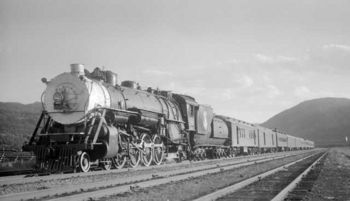Empire Builder
- This train inspired the popular Empire Builder board game and computer version.
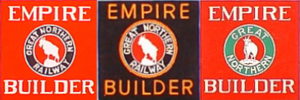
The Empire Builder is a passenger train route operated by Amtrak in the Midwestern and Northwestern United States. Before Amtrak, the Empire Builder was operated by the Great Northern Railway. The train was Great Northern's flagship train. The route runs from Chicago, Illinois toward the Pacific Ocean. The line splits in Spokane, Washington, terminating at Seattle, Washington's King Street Station (2,206 miles, or 3,550 km from Chicago) in the north and Portland, Oregon's Union Station (2,257 miles, or 3,632 km from Chicago) in the south.
The train passes through the states of Illinois, Wisconsin, Minnesota, North Dakota, Montana, Idaho, Washington, and Oregon. Layovers are made in Saint Paul, Minot, and Spokane. Other major stops on the route are Milwaukee, Fargo, Whitefish, Montana, and Vancouver, Washington.
One train passes in each direction on a daily basis. The schedule is timed so that the train will pass through the Rocky Mountains at a time of day that has prime viewing conditions. When trains run on schedule, it takes 45 to 46 hours to travel the entire route.
Contents
History
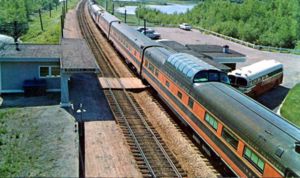
The original Empire Builder was inaugurated by the Great Northern on June 11, 1929. The service was altered to carry additional passengers during World War II. After the war, new diesel trains were placed into service. This postwar service began on February 23, 1947.
The route was publicized for allowing riders to view the passing Rocky Mountain landscapes of Glacier National Park through domed windows on top of the passenger cars. Ultimately, the name comes from the nickname given to railroad tycoon James J. Hill, who built track passing through Minneapolis-St. Paul in the late 19th century and founded the Great Northern Railway.
The service has run from Chicago to Spokane, and split into Seattle and Portland sections (except during the Amtrak era between 1971 and 1981, when there was no Portland section). The Chicago Union Station to St. Paul leg of the trains route was operated by the Chicago, Burlington and Quincy railroads mainline along the Mississippi River through Wisconsin.
After 1971 Amtrak assumed operation of the train and shifted the Chicago to St. Paul leg to the Milwaukee Road mainline route through Milwaukee.
Historical equipment used
The train's 1947 consist was as follows:
- Baggage-Mail car
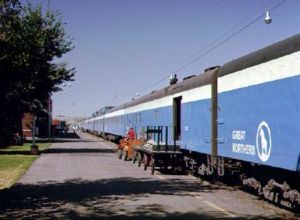
- "Chair" car / Coach (60 seats)
- "Chair" car / Coach (48 seats)
- "Chair" car / Coach (48 seats)
- "Chair" car / Coach (48 seats)
- Dormitory-Lunch Counter-Lounge
- Diner (36 seats)
- Sleeper (4 sections, 8 duplex roomettes, 4 double bedrooms)
- Sleeper (16 duplex roomettes, 4 double bedrooms)
- Sleeper (16 duplex roomettes, 4 double bedrooms)
- Sleeper (4 sections, 8 duplex roomettes, 4 double bedrooms)
- Sleeper-Observation (2 double bedrooms, 1 drawing room)
Car ownership on this train was by-and-large split between the Great Northern and the Chicago, Burlington and Quincy Railroad (CB&Q), though a couple of cars in the original consists were owned by the Spokane, Portland and Seattle Railway (SP&S). In this consist, one of the 48-seat "chair" cars and one of the 4-section sleepers were used for the connection to Portland, while the rest of the consist connected to Seattle.
Additional information on cars used
The Great Northern coaches eventually found their way into state-subsidized commuter service for the Central Railroad of New Jersey after the Burlington Northern merger and remained until 1987 when NJ Transit retired its last E8A locomotive. Some of these cars remain in New Jersey. Some coaches were acquired from the Union Pacific; these also went to New Jersey. One of the 28 seat coach-dinette cars also remains in New Jersey and is stored near Interstate 78 wearing tattered Amtrak colors.
Current equipment used
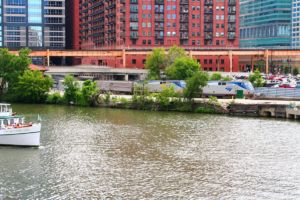
The present-day Empire Builder uses Amtrak's double-deck Superliner equipment. In Summer, 2005 the train was "re-launched" with newly-refurbished equipment. A typical 2005 train consist would be (destination noted after the Spokane split):
- Baggage car (Seattle)
- Transitional Crew Sleeper (Seattle)
- Sleeper (Seattle)
- Sleeper (Seattle)
- Diner (Seattle)
- Coach (Seattle)
- Coach (Seattle)
- Sightseer Lounge/Café (Portland)
- Coach/Baggage (Portland)
- Coach (Portland)
- Sleeper (Portland)
Station stops
Amtrak's Empire Builder operates as train 7 westbound and 8 eastbound, with 27 and 28 splitting at Spokane for Portland. It makes the following station stops:
- Wolf Point
- Glasgow
- Malta
- Havre
- Shelby
- Cut Bank
- Browning
- East Glacier Park
- Essex
- West Glacier
- Whitefish
- Libby
To/from Portland (splits at Spokane)
References
- Wayner, Robert J., ed. (1972), Car Names, Numbers and Consists, Wayner Publications, New York, NY
- Yenne, Bill (2005). Great Northern Empire Builder (Great Passenger Trains). Motorbooks International (MBI). ISBN 0-7603-1847-6.
